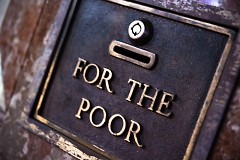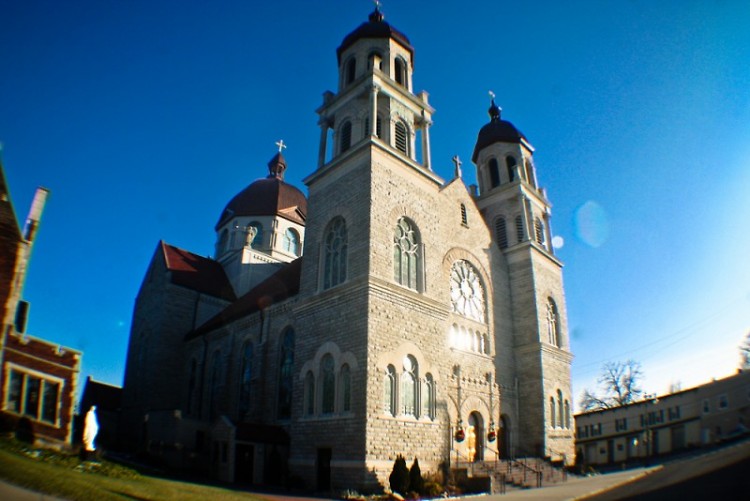
For the Poor Charity Box, Basilica of St. Adalbert /Steven Depolo

Facade Exterior Basilica of St. Adalbert /Steven Depolo

For the Poor Charity Box, Basilica of St. Adalbert /Steven Depolo
Most Grand Rapidians pass by the churches and aid society buildings on the city’s west side without realizing the impact those organizations once had on the waves of immigrants that came to our city around the turn of the last century, but the history those buildings saw helped to mold the character of the city, and not all of it was happy or peaceful.
Recently the Grand Rapids Polish Falcon Aid Society, whose motto is “First to fight, first to help out,” was in the news for renovating the exterior of its Fulton building. The PFAS hopes to be able to recoup those costs by continuing to serve as a welcoming place and a supporting organization for its community members. Back in 1927, however, when this PFAS branch was founded, it had an even more vital role to play. Waves of Germans and Irish had settled here, but then Poles came in large numbers too. Most of these immigrants did not speak English and were Catholic (whereas the city’s leadership and its other large ethnic group, the Dutch, were Protestant).
In the 19th century, there was no tax-supported social safety net. Food stamps, subsidized housing, and Medicaid didn’t exist, and these newcomers supported themselves mining gypsum or working in the furniture factories. These jobs were poorly paid and sometimes dangerous, but without these incomes, their families would have starved. As a result of both this vulnerability and a need for socializing and support, aid societies and halls sprang up. After all, worker safety was not a large concern, nor was an employer held liable after an accident. So when a man was injured or died or when a house burned down, Catholics on the west side of Grand Rapids could only count on their churches and societies to lend a hand.
Interestingly enough, these types of organizations were controversial in their time. The local Catholic community was led by Bishop Henry Richter from 1883 to his death in 1916. Bishop Richter was a German who immigrated to Ohio as a teenager and later was educated in Rome. He was appointed as the first bishop to the newly organized Diocese of Grand Rapids, and he was strongly in favor of encouraging immigrants to assimilate to the greater American culture rather than cling to their native cultures. When he began serving as bishop, he insisted that all parishes formed within the diocese be named for general saints, rather than saints that were honored in their native countries.
The Poles who originally settled in the city were from the German ruled area of what is now Poland. They spoke German, and many of them were skilled tradesmen who found work as carpenters, blacksmiths, and wagon makers. For them, the German parish of St. Mary’s was their first home, but as their numbers grew, they began to want their own Polish parish, and this lead to the establishment and building of St. Adalbert in 1881.
Some distance away on the northeast side of the city, more Poles settled, finding work in the area then known as the Brickyard. For some years, they and their children walked the three miles to St. Adalbert for church and school, but eventually they formed a building committee and in 1897 work began on a new church - the one we now know as St. Isidore’s. It may seem unbelievable now, but the naming of this church was the center of controversy.
The Polish people in the Brickyard part of the city wanted to choose their own patron saint and the name of their church, and they, under the direction of Father Simon Ponganis picked St. Stanislaus. On the day of the blessing of the cornerstone, however, Bishop Richter said the prayer and named it St. Isidore. According to one report Father Ponganis left mid-ceremony.
For these immigrants the Catholic Church held much more authority in their lives than the legal authorities did, and the bishop and priests tried to maintain their monopoly on that power. Bishop Richter threatened Catholics with excommunication if they attended unapproved fairs and bazaars, and Father Ponganis attempted to control which lay associations and benevolent or fraternal societies received approval. Parishioners did not fail to make their opinions known, though. Bishop Richter closed down one parish and placed it under interdict because the factions within it broke out in violence and rioting.
Of course, it wasn’t all controversy and in-fighting. These immigrant communities - Polish, German, Irish, and Dutch - came together time and again in good times and in bad to lend a hand and rebuild after floods, fires, and strikes, and they saved money to bring more relatives over from Europe so they too could have more opportunity. Anyone who thinks that immigrants are a recent phenomenon in Grand Rapids’ Westside isn’t paying attention to the architectural history within their midst.
The Rapidian, a program of the 501(c)3 nonprofit Community Media Center, relies on the community’s support to help cover the cost of training reporters and publishing content.
We need your help.
If each of our readers and content creators who values this community platform help support its creation and maintenance, The Rapidian can continue to educate and facilitate a conversation around issues for years to come.
Please support The Rapidian and make a contribution today.